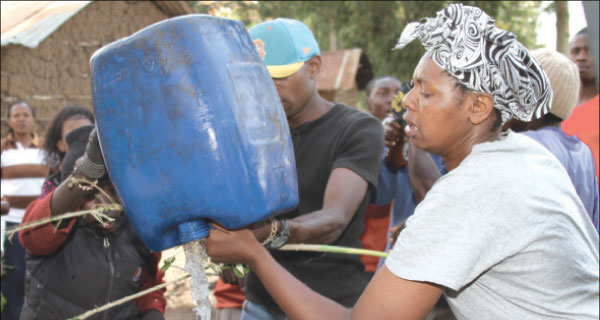 |
|
Women lead demonstrations against consumption of brews in Central. [PHOTO: FILE/STANDARD] |
By Standard Reporter
Alcohol abuse among young people in education institutions has risen to 71 per cent, while children — some as young as 10 — report using alcohol and make up an astonishing 8 per cent of those who have abused alcohol. This is according to a report by Nacada conducted three years ago but concealed from the public until now.
The report, completed in 2010 that researched alcohol abuse across the country, shows Central Province with the most disturbing numbers of youth abusing alcohol, leading to drastic social changes that include decreasing population, drop in school attendance and rising crime.
The document titled: Situation of alcohol abuse in Kenya, provides stunning details about young people abusing alcohol and the challenges the Government faces in dealing with the vice.
“Alcohol is the most abused substance in Kenya. Alcohol abuse is fueled by a permissive society, easy access and affordability,” it says.
The report says weak regulatory mechanism, advertising and promotion and peer pressure add to the list of contributors to growing alcohol abuse. It warns that the abuse is severe among the youth population by “diminishing their learning ability, truancy from school, road accidents and loss of work productivity.”
Even worse, the proliferation of illicit and cheap brews that are targeted at the bottom of the pyramid consumers in slums and in rural towns are contributing to the growing numbers of deaths across the country. Most of these brews are made in unhygienic conditions with concoctions of lethal chemicals and the history of death across the country is documented.
According to the report, at least 39 per cent of Kenyans between 15-65 have abused alcohol and the numbers rise when it comes to abuse among young people in educational institutions. The report says: “Alcohol abuse among persons in learning institutions went up by 71 per cent over the period 2003-2007. The worst hit we found to be universities and other tertiary institutions.”
Central Province is rated as the worst in terms on magnitude of alcohol abuse. The report reveals that in survey done between May and June 2010 dubbed Third wave of rapid results initiative, the levels of consumptions were “very high, over 40 per cent of people interviewed said the consumption is “very high”.
Highest consumers
The most affected population in the province is the youth – both male and female – with the 25-34 age group marked as the highest consumers.
Male youth accounted for 89 per cent in this group. Males also made up 77 per cent of drinkers within the 19-24 age groups.
The report attributes the wave of high alcohol consumption growth among youth to the “use of 2nd generation alcohol” referred to as the cheap brand of alcohol found in slums or informal settlements and rural areas. It says that 74 per cent of those interviewed in the report declared that the “alcohol was more easily available compared to other types of alcohol.”
Even more startling, 81 per cent of those interviewed say the second generation drinks were attractive because of cost, making it “affordable”.
In addition, the report reveals that 60 per cent of alcohol abusers in central province hit the bars before noon – the most productive hours of the day – which explains low work and declining economic activity in the province.
Stay informed. Subscribe to our newsletter
Nairobi is ranked next to central in terms of alcohol abuse, and affects all age groups as well as social-economic backgrounds.
And it reveals that 32 per cent of churchgoers drink alcohol while alcohol and drug consumption is high in the city among the youth aged between 15 and 25 years.
The report reveals: “In Nairobi, 88 per cent of parents confirmed they would not know if their child was abusing alcohol or other drugs…70 per cent of parents indicated that alcohol is easily available to the youth in estates and in town, but they were powerless on what to do about the situation.”
The report illustrates the effect of alcohol among the youth amidst the 15-35 age group as the most worrying, with side effects witnessed on their education and employment.
“Alcohol diminishes the still developing brain of young persons, hence diminishing their learning ability and retention of information. Youth who engage in alcohol drinking fail to cope with class work and school rules leading to dropping out or expulsions.”
In Central region, the report says, 43 per cent of respondents reported that alcohol consumption had contributed to low school enrollment and a 47 per cent school drop out with a further 44 per cent being attributed alcohol to poor national exams performance.
In addition, youth consumers were affected by impaired judgment and made it difficult for them to be hired since they could not perform given tasks.” Such persons cannot be employed or retained in employment due to their incapacity”.
In the central province study, nearly 80 per cent of respondents said alcohol consumption had made young people too weak to be employed employable or to engage in productive activities.
Alcohol consumption is also attributed to increase growth of risky sexual behavior and exposure to sexually transmitted disease including HIV and Aids. In Central alone, the report attributed alcohol consumption to marital breakdown (87 per cent of respondents), reduce interest sexual activity and infertility. Sociologists have already raised the alarm bells over the fall in population in central province with some nursery schools in some counties closing due to lack of pupils or recording alarming enrolment drops.
The report attributed lack of voting (32 per cent of respondents) to alcohol and warns of its effects on vision 2030 goals. The report says: “A majority of alcohol abuse victims are in their prime of productivity hence their incapacity is a serious blow to attain of the country’s development goals such as Vision 2030 and MDGs.
 The Standard Group Plc is a
multi-media organization with investments in media platforms spanning newspaper
print operations, television, radio broadcasting, digital and online services. The
Standard Group is recognized as a leading multi-media house in Kenya with a key
influence in matters of national and international interest.
The Standard Group Plc is a
multi-media organization with investments in media platforms spanning newspaper
print operations, television, radio broadcasting, digital and online services. The
Standard Group is recognized as a leading multi-media house in Kenya with a key
influence in matters of national and international interest.
 The Standard Group Plc is a
multi-media organization with investments in media platforms spanning newspaper
print operations, television, radio broadcasting, digital and online services. The
Standard Group is recognized as a leading multi-media house in Kenya with a key
influence in matters of national and international interest.
The Standard Group Plc is a
multi-media organization with investments in media platforms spanning newspaper
print operations, television, radio broadcasting, digital and online services. The
Standard Group is recognized as a leading multi-media house in Kenya with a key
influence in matters of national and international interest.










